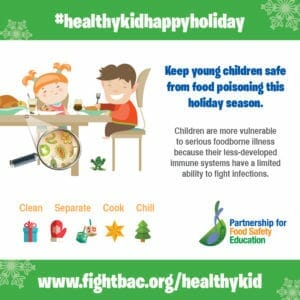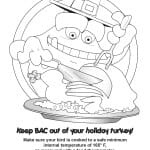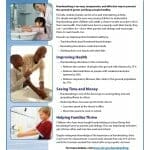The most valuable source of statistical data about foodborne illness in the United States is FoodNet, the Center for Disease Control and Prevention’s national foodborne illness surveillance system. Based on data collected through FoodNet and other sources, the CDC estimates that 48 million Americans are sickened by foodborne illness each year (CDC, 2011), and that children under 15 years of age account for approximately half of all foodborne illness in the U.S. (CDC, 2009). Young children (under five years old) experience the highest rates of foodborne illness. They are more susceptible to foodborne illness than adults for several reasons:
- Children’s immune systems are not yet fully developed so their ability to fight infection is reduced;
- Children have a lower body weight so a smaller dose of a pathogen can make them sick;
- Children have limited control over their diet and related food safety risks.
Parents and caregivers can take many steps to protect children from foodborne illness! We’ve put together this page of resources to ensure you have healthy kids for a happy holiday!

For Parents and Caregivers
#healthykidhappyholiday social media postcard
Food Safety for Children under 5 in English | in Spanish
Fight BAC! Basic Brochure
The Crib Sheet is an 8-page guide to protecting babies and young children from foodborne illness. Developed by The Partnership for Food Safety Education. For childcare information go here.
Crib Sheet English | Crib Sheet Spanish
Crib Sheet – Clean Hands: Handwashing is the single most effective way to prevent the spread of disease.
Crib Sheet – Cleaning and Sanitizing Surfaces: Dangerous germs can live on surfaces for several weeks.
Crib Sheet – Bottles, Formula, Breast Milk: Everything about cleaning and sterilizing bottles and preparing and storing formula.
Crib Sheet – Baby Food: Safely handling, storing and serving foods for your baby.
Crib Sheet – Diapers: Taking care to reduce risk of cross contamination in your home.
Coloring Pages and Posters for Kids – print at home!
 Coloring Page – BAC w/ Cookie Dough
Coloring Page – BAC w/ Cookie Dough
 Coloring Page – Keep BAC out of holiday turkey
Coloring Page – Keep BAC out of holiday turkey
 Happy Fingers Happy Hands Song Flyer
Happy Fingers Happy Hands Song Flyer
 Superheroes Handwashing poster (source CDC)
Superheroes Handwashing poster (source CDC)
 Princess Handwashing poster (source CDC)
Princess Handwashing poster (source CDC)
 Family Handwashing poster (source CDC)
Family Handwashing poster (source CDC)
 One Trillion Germs poster (source CDC)
One Trillion Germs poster (source CDC)
More information on children and foodborne illness from the Center for Foodborne Illness Research and Prevention.